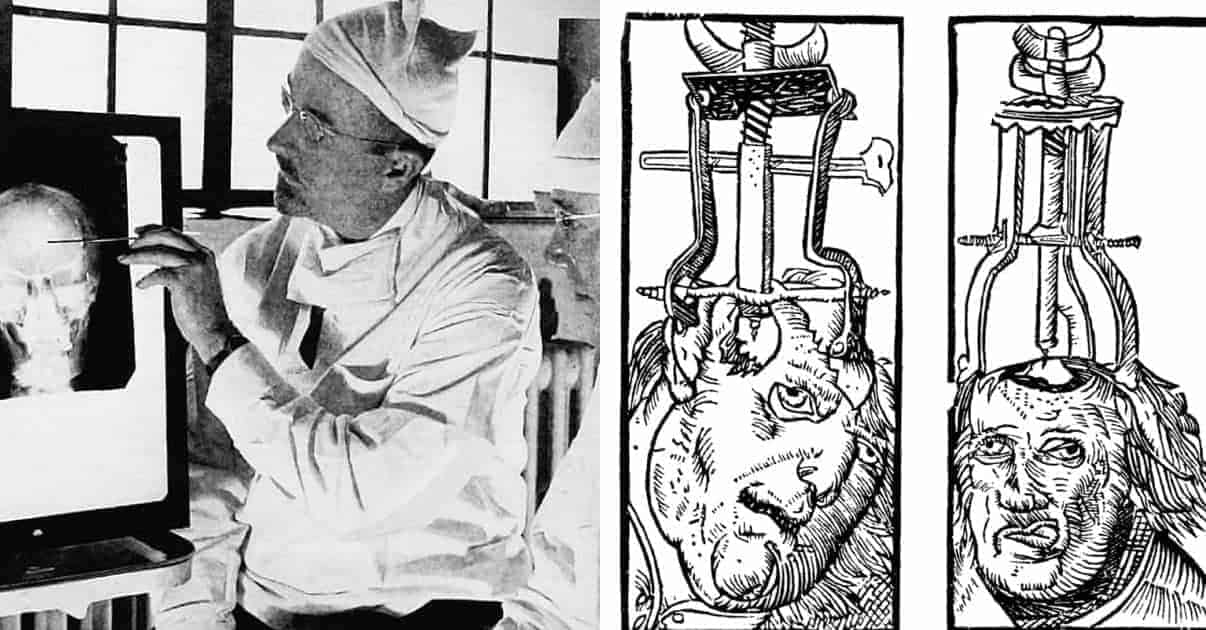“The art of medicine,” wrote Voltaire, “consists of amusing the patient while nature cures the disease.” Some of the medical treatments of Voltaire’s day and since haven’t been too amusing however. George Washington was stricken with an infection which in a later day would have been treated with the antibiotics unavailable to his physicians. Armed only with the medical knowledge and practices of the time, they repeatedly bled their patient, further weakening him and no doubt hastening his death. Bleeding was long an accepted medical practice, for a wide variety of complaints, and doctors found it useful for a treatment. Sometimes the patient survived, though it is highly unlikely the ministrations of the physicians contributed to the cure.
There are many medical procedures and practices formerly used to treat patients that added to the discomfort and indignities of being ill, all highly regarded in their day. Trepanning, which is defined below, was used since ancient times to release evil spirits and humors from deranged minds. Mercury, which is a highly toxic heavy metal, was the prescribed treatment for syphilis. The practice of lobotomy was used in cases of mental illnesses; John F. Kennedy’s sister Rosemary was lobotomized in an attempt to control her mood swings at the age of 23, on the advice of her doctors.

Here are some formerly highly regarded medical practices and procedures which have thankfully been abandoned by professionals in the health care disciplines.

Bleeding the patient
Physicians once subscribed to the theory that the human body contained four fluids, which in the medical literature of the day, such as it was, were called humours. These were blood, bile in two forms – black and yellow, and mucous, or phlegm. Disease occurred when an imbalance in the humours was present. The practice of restoring the proper balance of humours dates to ancient times and remained an important part of the physician’s arsenal of weapons against illness well into the 1800s. Many of the earliest surgical tools were designed to promote the release of blood.
The founder of the art of medicine, Hippocrates, upon whom the oath to do no harm is based, believed that bleeding the patient was equivalent to female menstruation. To Hippocrates, menstruation corrected the imbalance of humours present in the female body. Doctors in the ancient world were unaware of blood circulating, and believed that it grew stagnant when in the extremities leading to illness. Once the Roman doctor Galen discovered that there was blood present in the arteries, which had previously been believed to contain air, he derived a complex system of bleeding patients. Galen’s system included consideration of a patient’s age and overall physical health, the particular complaint being treated, and even the weather, among other considerations.
By the 1600s, physicians in Europe often recommended bleeding to their patients, but the actual procedure was beneath their dignity and was usually performed by barbers, who doubled as surgeons. Through several different methods, including the drawing of blood from veins opened with lancets, cupping, or occasionally the tapping of arteries, blood was withdrawn with the goal of the barber being inducing the patient to faint. Some surgeons used leeches to rid their patients of the bad humours, a practice which continued for centuries.
As early as the 1600s doctors in Europe were demonstrating that the practice of bleeding was of no benefit to the patient in nearly all instances, but doctors continued the practice for another two centuries, often because the medical training and knowledge of the time presented them with no other options and they had to do something. Bleeding was done both when the patient was unwell and as a routine preventative. Bleeding through the application of leeches was especially popular as a prophylactic treatment. Bleeding was even used as a treatment for nosebleeds.
As George Washington lay weakened from a throat infection (widely believed today to have been quinsy) his learned physicians eventually withdrew nearly four quarts of his blood. To be fair, Washington requested the procedure and his doctor’s complied. It may be one reason that his last words were reported to have been, “No, doctor. Nothing more.”

